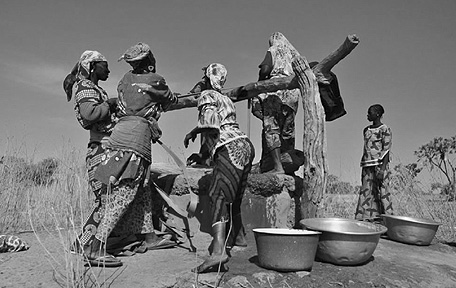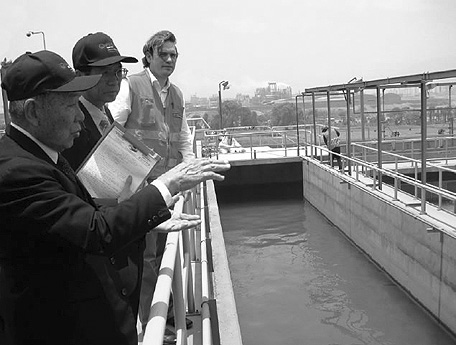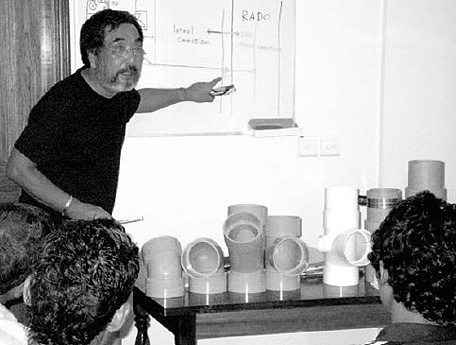Japan's Official Development Assistance White Paper 2011
(3) Water and Sanitation
Water and sanitation is a serious issue related to human life. In 2008, approximately 884 million people worldwide had no access to safe drinking water such as water supply or wells and approximately 2.6 billion people—about a half of the population of developing countries—had no access to basic sanitation such as sewage systems.(Note 9) More than 1.5 million children under five years old lose their lives annually due to a diarrhea caused by a lack of safe water and basic sanitation facilities.(Note 10)
<Japan's Efforts>
At the 4th World Water Forum in 2006, Japan announced the Water and Sanitation Broad Partnership Initiative (WASABI). Japan's disbursements of aid for water and sanitation are the largest in the world. Japan provides comprehensive support for both the knowledge and expertise aspect and the equipment and facilities aspect by utilizing its wealth of experience, knowledge, and technology in the following; (i) promotion of integrated water resources management, (ii) provision of safe drinking water and sanitation (improvement of sanitation facilities), (iii) support regarding water use for food production and other purposes (use of agricultural water, etc.), (iv) water pollution prevention (establishing effluent regulations) and ecosystem conservation (conservation of vegetation and sustainable forest management etc), and (v) mitigation of damage from water-related disasters (establishment of an early warning system and strengthening the disaster response capacities of individuals and local communities).
At the Fourth Tokyo International Conference on African Development (TICAD-IV) in May 2008, Japan announced support for (i) promoting the development of water and sanitation facilities to provide safe drinking water to 6.5 million people, (ii) capacity building of 5,000 people on water resources management, and (iii) dispatch of the Water Security Action Team (W-SAT).* (see the figure on page 116 for details regarding TICAD) As of the end of March 2011, over 3.6 million people had received the benefits of ODA loan/grant aid for water and sanitation. Further, in December 2010, Japan led the way in the adoption by the U.N. General Assembly resolution of follow-up of the International Year of Sanitation (2008), and is supporting global efforts to achieve "Sustainable Sanitation: Five-year Drive to 2015," by the 2015 deadline for achievement of the MDGs.

Nigerien women draw water from a well in a village where a Japan Overseas Cooperation Volunteer works (Photo: Seico Tamai)

A Japanese evaluation team inspects the site of the "North Lima Metropolitan Area Water Supply and Sewerage Optimization Project" that Japan implemented in Peru
Terminology
*Water Security Action Team (W-SAT)
Japan Overseas Cooperation Volunteers, Senior Volunteers, and other technical experts from Japan are dispatched to Africa to provide technical guidance to enable the stable use of safe water. The Team conducts a wide range of activities, including ensuring safe water, maintenance and management of water supply facilities, and improvement of sanitary conditions related to water use.
Notes:
(9) Source: "Progress on Sanitation and Drinking-Water: 2010 Update"(WHO/UNICEF, 2010)
(10) Source: "Progress for Children: A Report Card on Water and Sanitation" (UNICEF, 2006)
[Maldives]
"Sewage and Ground Water Management Project"
Technical Cooperation Project (January 2009 - December 2010)
The government of the Maldives has set the goal of providing sewage facilities to all of its inhabited islands. However, the spread of sewage treatment facilities and the sewer system has just begun, and the Ministry of Home Affairs and Environment and the Environmental Protection Agency, the organizations in charge of carrying out the plan, has almost no experience in the design, construction, maintenance, and operation of sewage treatment facilities. In this context, the project has set goals to improve the ability of the Ministry of Home Affairs and Environment and the Environmental Protection Agency in designing, maintenance, and management, specifically, the ability to make specifications to outsource the design and construction of sewage treatment facilities to subcontractors, and supervise the residents of each island on the maintenance of the completed facilities. To achieve these goals, specialists were dispatched to provide direct, onsite guidance for the creation of guidelines for the formulation of design specifications, creation of maintenance and management manuals, etc., in addition to conducting training in Japan to provide an understanding of sewage treatment facilities. By this project, sewage treatment facilities are expected to be spread throughout the Maldives in the future, and appropriately maintained and managed.

A Japanese specialist conducts training on pipe connections (Photo: Yachiyo Engineering)
